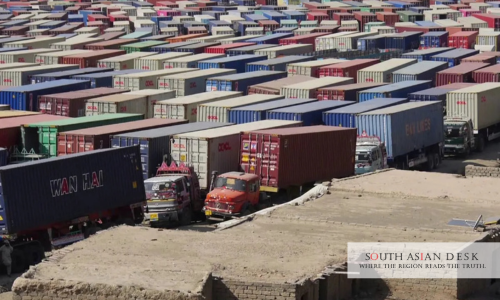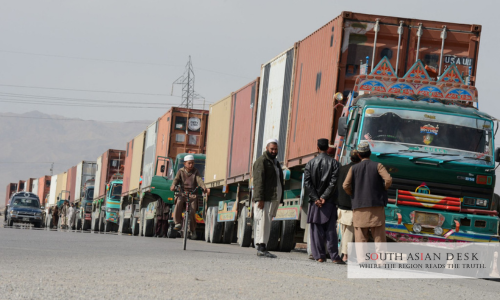Afghanistan and Pakistan trade volume hit $143 million USD in August 2025, up 4 per cent from July, as reduced customs tariffs and reopened border crossings boosted Afghan exports by 50 per cent year-on-year, according to official data from the Afghan Ministry of Industry and Commerce; the exchange occurred primarily via Torkham, Ghulam Khan, and Dand Patan borders to support economic recovery in both nations.
Why it Matters
The uptick in Afghanistan and Pakistan trade underscores a fragile yet promising lifeline for two economies scarred by conflict and isolation. In South Asia, where cross-border commerce often falters amid geopolitical tensions, this growth, driven by agricultural exports and tariff relief—could stabilise food security in landlocked Afghanistan and bolster Pakistan’s export markets. It signals potential for regional integration, easing humanitarian strains and fostering stability from the Hindu Kush to the Arabian Sea, though security hurdles remain a drag on fuller prosperity.
Boost in Afghanistan and Pakistan Trade Amid Tariff Cuts
The Afghanistan-Pakistan trade landscape showed resilience in August 2025, with total bilateral exchanges climbing to $143 million USD, reflecting a 4 per cent month-on-month rise from $137 million USD in July. This progress, reported by the Afghanistan and Pakistan Joint Chamber of Commerce, stemmed largely from a 50 per cent year-on-year surge in Afghanistan’s exports to Pakistan, reaching $55 million USD from $37 million USD the prior month.
Key drivers included seasonal fruit shipments and policy tweaks, such as lowered customs duties on select Afghan goods, which facilitated smoother flows through vital crossings like Torkham and Ghulam Khan. Pakistani exports to Afghanistan, however, dipped slightly by 1 per cent month-on-month to $88 million USD, alongside a 13 per cent year-on-year decline, highlighting an imbalance where Pakistan dominates inflows of essentials like rice and textiles.
Omid Haidari, a Kabul-based businessman, emphasised the need for sustained momentum, stating: “We request Pakistan’s leadership to reduce tariffs to a minimum. First of all, mutual trust should be built, and trade, customs, and transit agreements between Kabul and Islamabad should be signed to assist traders on both sides.”
This month’s figures build on a robust first half of 2025, where Afghanistan-Pakistan trade neared $1 billion USD overall, $989 million USD precisely, with Afghan outflows at $277 million USD and Pakistani at $712 million USD, per Afghan Ministry data. Yet, July saw a 12 per cent dip to $138 million USD, underscoring volatility tied to seasonal and policy factors.
Key Commodities Fueling Afghanistan-Pakistan Trade

Afghan exports are centred on fresh produce, with the Ministry of Agriculture, Irrigation and Livestock noting eased conditions for shipments via Dand Patan. Fruits and vegetables dominated, capitalising on the harvest peak before its close, which contributed to the 16 per cent month-on-month export leap.
In contrast, Pakistan supplied $88 million USD in goods, including Sella rice, medical drugs, sugar, and cotton textiles, vital for Afghan markets amid ongoing recovery efforts. Khanjan Alokozay, President of the Afghanistan-Pakistan Joint Chamber of Commerce, attributed the upswing to timely interventions: “Exports have increased compared to last year and also compared to last month, because a month ago tariffs were high, and the fruit season had not yet started.”
These dynamics illustrate how Afghanistan-Pakistan trade hinges on agriculture, which accounts for over 60 per cent of Afghan exports to its neighbour, per chamber estimates. Infrastructure gaps, however, loom large; Mirwais Haji Zada, First Deputy of the Chamber of Agriculture and Livestock, urged action: “The fruit season has ended this year, and facilities must be provided for traders facing difficulties. A railway line should be built so that traders can export to other countries as well.”
Challenges Persist in Afghanistan-Pakistan Trade
Despite the August gains, Afghanistan-Pakistan trade faces structural headwinds. Border facilities at Torkham and Chaman remain inadequate, with traders reporting delays that erode perishable goods’ value. Historical closures—such as the March 2025 Torkham shutdown over outpost disputes, which cost $15 million USD in losses—underscore fragility, though reopenings have since stabilised flows.
The fiscal year 2024-25 closed at $1.99 billion USD in total Afghanistan-Pakistan trade, a 25 per cent rise from $1.60 billion USD the prior year, driven by anti-smuggling measures that redirected informal flows into formal channels. Yet, transit trade via Pakistan plummeted 84 per cent in early 2025 to $836 million USD, reflecting tightened controls on re-exports.
Official voices from both sides advocate for bilateral pacts. The Afghan Ministry’s earlier assessment confirmed: Trade challenges between Afghanistan and Pakistan had eased, and exports to Pakistan were proceeding normally. Pakistani counterparts echo this, with data from Islamabad’s Federal Board of Revenue aligning with the $143 million USD August tally.
Background
Afghanistan-Pakistan trade has long been a barometer of neighbourly ties, evolving from pre-2021 peaks of $2.5 billion USD annually to post-Taliban dips amid sanctions and militancy. The 2,600 km Durand Line border, dotted with crossings like Torkham (handling 40 per cent of volume), has seen repeated disruptions—from 2023 clashes stranding 5,000 trucks to 2025’s tariff rows.
Under the Taliban administration, Kabul prioritises diversification, yet Pakistan absorbs 30 per cent of Afghan exports, per 2025 ministry figures. Islamabad, facing its own economic pressures, views the route as a gateway to Central Asia, with bilateral volumes rebounding via diplomatic thaws, including April 2025 talks in Kabul.
This interplay not only sustains livelihoods—employing thousands in trucking and farming but also mitigates refugee flows, as stable Afghanistan-Pakistan trade reduces migration drivers.
What’s Next for Afghanistan-Pakistan Trade
Looking ahead, stakeholders eye a $2 billion USD annual target for 2025, contingent on new transit accords and rail links. With September harvests winding down, focus shifts to non-perishables like coal and spices, potentially sustaining the 4 per cent growth trajectory. Enhanced trust, as Haidari noted, could unlock $6 billion USD in potential, transforming Afghanistan-Pakistan trade into a South Asian powerhouse.
Published in SouthAsianDesk, September 24th, 2025
Follow SouthAsianDesk on X, Instagram, and Facebook for insights on business and current affairs from across South Asia.






